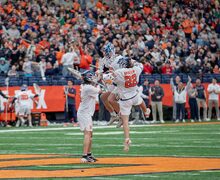Increased enrollment leads to changes to housing lottery, presents challenges for on-campus housing
Tony Chao I Art Director
When the housing lottery ended last spring, about 200 Syracuse University students were locked out of on-campus housing.
The students, who all still needed to fulfill their two-year campus housing requirement, eventually found places to live, but the overflow is a major reason SU has decided to make changes to the housing lottery next semester.
“Growing enrollment over the last few years has really challenged us as a campus to figure out what students are housed and where,” said Terra Peckskamp, director of the Office of Residence Life.
Large incoming classes the last two years prompted the housing lottery changes, but rising enrollment — and the housing problems it presents — are not new issues at SU. To combat the housing crunch, SU has housed students in hotels and converted lounges into dorm rooms. As the university works to find more space on campus, the creation of a Campus Master Plan will play a large role in determining what’s next for campus housing.
The biggest change to the lottery is that students who have not already fulfilled their two-year on-campus housing requirement won’t be able to select single rooms during the housing lottery this spring. Options will also be more limited for upperclassmen that have already fulfilled the requirement.
The new rules essentially require sophomores to choose a roommate to go through the housing process, a change that reflects the reality of what already happens, said Eileen Simmons, director of the Office of Housing, Meal Cards and ID Services. In past years, less than five students who still needed to fulfill their housing requirement were able to land a single, she said.
“I think it will take a level of angst away from the freshmen to not put all their eggs in one basket for a single room when the reality is, over the years, two-year (requirement) students during the lottery aren’t able to secure one,” Simmons said.
Although the large freshmen and sophomore classes prompted the most recent changes to the housing lottery, enrollment increases are not a new issue on campus. Prior to 2005, Nancy Cantor’s first year as chancellor, the freshman class typically consisted of about 2,600 students. After planned increases and higher rates of enrollment under Cantor, the average size of the freshman class is now about 3,400 students. But the current freshman and sophomore classes are even larger than the 3,400 average, coming in at 3,478 and 3,463, respectively.
Chris Sedore, senior vice president for enrollment management, said in an email that he expects the Fall 2015 class to be smaller than the last two years, but that the final class size will be determined later in the admissions process.
While smaller class sizes will help, SU is also looking to several short-term and long-term solutions to alleviate the housing crunch. The university first housed students in the Sheraton Hotel and Conference Center in 2005 and began doing it again during the 2011–12 school year. After not housing students during the 2012–13 school year, the hotel has been a housing option since fall 2013 and students will continue to live there next year.
There are no current plans to build new dorms on campus, but Simmons said the Campus Master Plan, which is currently being created as part of the Fast Forward Initiative, will play a role in determining future dorm construction. SU is still committed to the two-year housing requirement, and there has been no discussion about changing the requirement, Simmons said.
Another temporary solution to housing students is converting dorm study lounges into living spaces. Simmons estimates there are about 80 students currently living in lounges. Since most lounges are triples, that amounts to about 26 converted lounges across campus, she said.
The university is strategic about which lounges it converts, Simmons said. For example, DellPlain Hall has two lounges on every floor, so converting one lounge on each floor means students aren’t completely without lounge space. SU is also trying to create other spaces for students to study, such as the new lounge in Haven Hall, which is open 24/7, she said.
“If that room or study space does need to be turned into some kind of living space, there also needs to be an option of, where else are we going to put this study space?” said Residence Hall Association president Malik Evans.
Evans said the recently renovated Haven Hall space is a good example of a new study space but added that he thinks computers need to be available there as well.
The Office of Residence Life is currently monitoring the usage of the Haven Hall space and this will help the office in setting up future study spaces, said Peckskamp, the ORL director. But whether or not lounges are converted depends on the size of the freshman class, which is difficult to predict, she said.
“While I would love to say we’re not going to be in lounges, it’s a very intricate ability to balance occupancy because we never know quite how many first year students we are going to get,” Peckskamp said. “Admissions has a target and they’re pretty good about meeting it but if we’re over by 10, then that’s 10 beds we’ve got to find. It’s a challenging issue.”
Published on December 3, 2014 at 12:01 am
Contact Jessica: jliannet@syr.edu | @JessicaIannetta





